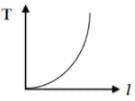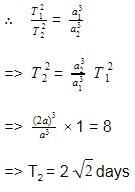DCE CEE Previous Year Paper 1999 - JEE MCQ
30 Questions MCQ Test - DCE CEE Previous Year Paper 1999
If an electron oscillates at a frequency of 1 GHz it gives :
| 1 Crore+ students have signed up on EduRev. Have you? Download the App |
If a transparent slab of refractive index µ = 1.5 and thickness t = 2.5 × 10 -5m is inserted in front of one of the slits of Young's double slit experiment, how much will be the shift in the interference pattern? The distance between the slit is 0.5 mm and that between slit and screen is 100 cm ?
In India geostationary satellites are vertically above :
Which of the following is not the property of cathode rays ?
In case of simple pendulum, time period versus length is depicted by:
Which one of the following is a fusion reaction ?
The water droplets in free fall are spherical due to :
Which one of the following is not a scalar quantity ?
The degree of freedom in case of an monoatomic gas is :
If a Carnot engine is working with source temperature 227°C and sink temperature 27°C, its efficiency will be :
17. 10 days is the half-life of a sample. After how many days, the sample will becomes (1/32)nd of the original substance ?
18. What is the relation between displacement, time and acceleration in case of a body having uniform accelerating ?
20. Resolving power of a microscope depends upon :
21. A body is orbitting around earth at a mean radius which is two times as greater as the parking orbit of a satellite, the period of body is :
22. Following two wave trains are approaching each other y1 = a sin 200 πt, y2 = a sin 208 πt. The number of beats heard per second is :
23. One projectile moving with velocity v in space get burst into 2 parts of masses in the ratio of 1 : 2. The smaller part becomes stationary, velocity of other part is :
24. A charge is placed at the centre of a cube, what is the electric flux passing through one of its faces ?
26. If germanium is dopped with arsenic, that will result in :
27. Faraday's second law states that mass deposited on the electrode is directly proportional to :
28. One proton beam enters a magnetic field of 10 -4 Wb/m2 normally. If specific charge is 10 11 C/kg and velocity of proton is 10 9 m/s, then the radius of circle described will be :
29. A body of mass m1 is moving with velocity u. It collides with another stationary body of mass m2. They get embedded. At the point of collision, the velocity of the system :
30. A body of weight mg is hanging on a string which extends in length by l. The work done in extending the string is :






 we can notice that both V0 and u are the same, due to absence of external force on the system.
we can notice that both V0 and u are the same, due to absence of external force on the system.














